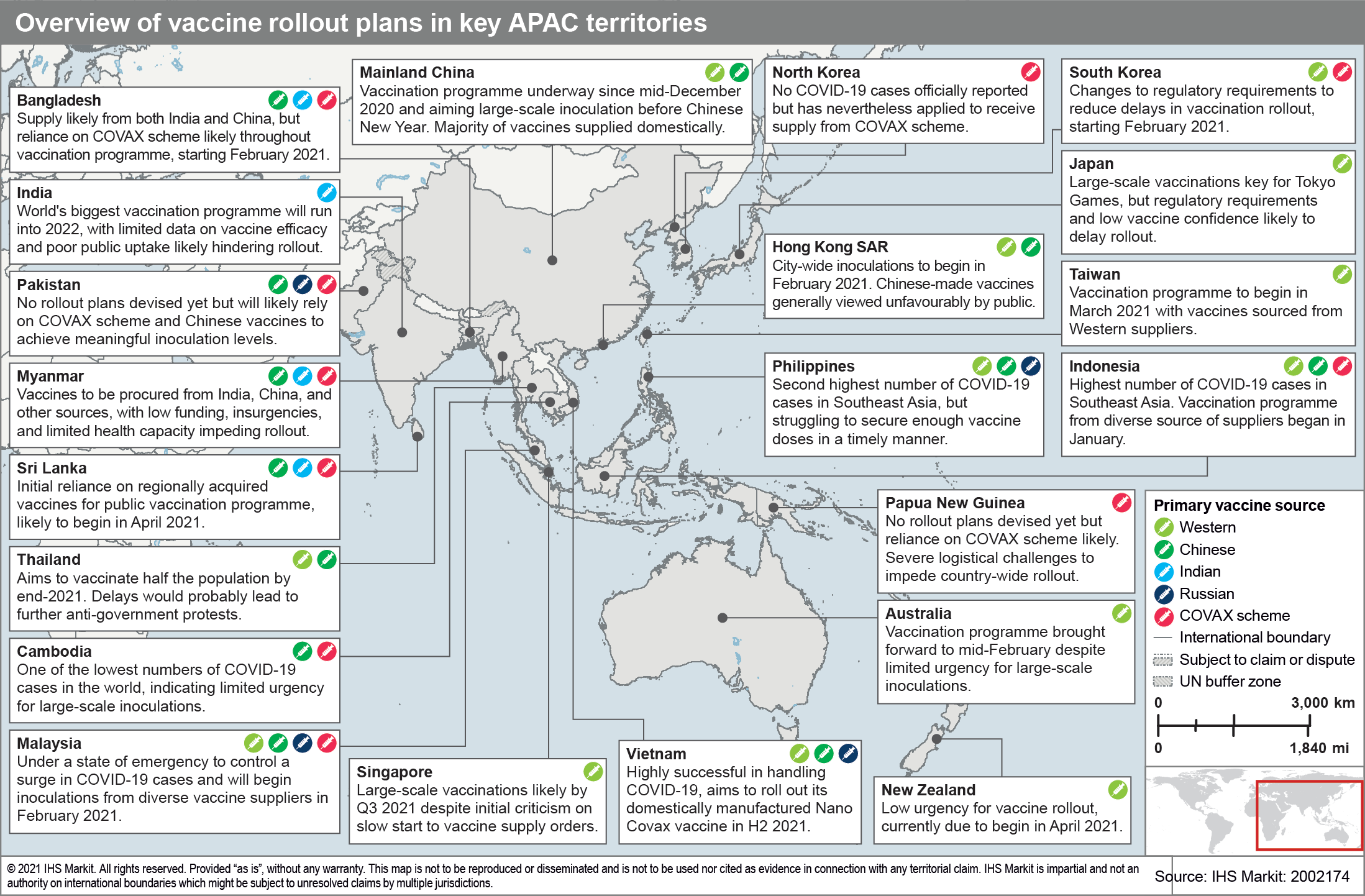S&P Global Offerings
Featured Topics
Featured Products
Events
S&P Global Offerings
Featured Topics
Featured Products
Events
S&P Global Offerings
Featured Topics
Featured Products
Events
Banking & Capital Markets
Economy & Finance
Energy Transition & Sustainability
Technology & Innovation
Podcasts & Newsletters
Banking & Capital Markets
Economy & Finance
Energy Transition & Sustainability
Technology & Innovation
Podcasts & Newsletters
S&P Global Offerings
Featured Topics
Featured Products
Events
BLOG — Mar 11, 2021
By Anton Alifandi, Asad Ali, Bree Neff, David Li, Deepa Kumar, Hannah Cotillon, Sacha Baggili, and Sophie Cairns
Domestic innovation and production capacity of coronavirus disease 2019 (COVID-19) vaccines have uniquely positioned China and India to be pivotal suppliers of vaccines within the Asia-Pacific region, and elsewhere. The development and production of COVID-19 vaccines are key political priorities for both countries, driven by geopolitical considerations and made possible by domestic manufacturing capabilities. Beijing is seeking diplomatic advantage in an increasingly adversarial external environment by providing vaccines to other countries. Sinovac Biotech has confirmed advanced purchase agreements (APAs) with Brazil, Chile, Indonesia, Malaysia, Mexico, the Philippines, Turkey, and Ukraine, while fellow Chinese company Sinopharm has agreements with Egypt, Morocco, Pakistan, Peru, and the United Arab Emirates. China's external push, however, will likely be marred by concerns about the reportedly low efficacy of its vaccines and poor transparency in declaring results of testing regimes. Reports of increasing domestic COVID-19 cases - notably in the provinces of Hebei and Heilongjiang - will probably also oblige China to prioritise local distribution ahead of exports.

China's domestic constraints are likely to give an advantage to India's vaccine diplomacy program, known as 'Vaccine Maitri'. India has the benefit of both extensive manufacturing capability - production of Covishield is expected to reach 100 million monthly doses by February 2021 - and higher reported vaccine efficacy. (Covishield is a licensed version of the Oxford-AstraZeneca vaccine manufactured locally by the Serum Institute of India, the world's largest vaccine manufacturer before COVID-19.) India has already sought to counter growing Chinese influence in the region by donating millions of Covishield doses to nine Indian Ocean countries, including Bangladesh, Mauritius, Nepal, Seychelles, and Sri Lanka. Additional non-regional, commercial deliveries have also been scheduled for Brazil, Morocco, Saudi Arabia, and South Africa.
Logistical and healthcare limitations will protract rollout completion
Major Asia-Pacific economies have already started - or aim to start - vaccination programs in the first quarter of 2021, with almost all countries prioritizing healthcare and frontline workers. A risk-positive development is the rapid development of cold chain infrastructure in advanced and emerging Asia-Pacific countries, involving private-sector efforts to complement state capacity. This will assist vaccine rollout, whose progression will likely enhance business confidence and reduce the need for national lockdowns.
However, rollouts in most countries faces a high likelihood of being extended into at least 2022. Large disparities in road infrastructure and healthcare provision are widespread within the region, potentially causing the most significant delays in countries with a high density of rural populations. Challenges facing these countries in supplying peripherals - such as syringes and personal protective equipment (PPE) - will further complicate rollouts. Consequently, the risk of localized lockdowns will persist throughout 2021 in specific regions with outbreaks. For instance, business and movement restrictions will likely be loosened in India, Indonesia, Malaysia, and the Philippines, whereas delays in rollout and new outbreaks would trigger region-specific lockdowns in Australia, Myanmar, Pakistan, and Sri Lanka. Throughout 2021, Hong Kong SAR, Taiwan, and Thailand will probably continue to have limited movement restrictions, whereas stringent lockdowns are most likely to be imposed in mainland China (around the Chinese New Year in February) and in Japan (in the run-up to the postponed Tokyo Games in July).
Successful vaccine rollout key to economic recovery
A successful rollout of vaccination programs will be critical, particularly in major economies in which consumer and business demands are key growth drivers. IHS Markit estimates real GDP growth for the Asia Pacific at 5.7% for 2021 - the strongest regional expansion since 2010. The sharp rebound in economic activity, however, will primarily be due to favorable base effects after a weak 2020. Moreover, given that GDP growth reached 7.1% in 2010, this recovery is not especially robust, considering the magnitude of the contraction in 2020.
A meaningful recovery for most countries is unlikely until they return to their pre-pandemic levels of real GDP output in 2021-22. This is underpinned by the importance of expanding private consumption and fixed investment in several countries where these account for 70-80% of GDP (except for outliers like the Philippines and Singapore). Achieving high demand-driven growth is very dependent on successful vaccine rollouts, with the highest risk facing geographically remote and dispersed economies. Furthermore, many governments are likely to start unwinding pandemic-related fiscal stimulus measures in 2021, which will almost certainly drag on growth. They are also likely to reprioritize other spending towards vaccination campaigns, although that would not offset broader budget trimming efforts.
Posted 11 March 2021 by Anton Alifandi, Associate Director, Country Risk, S&P Global Market Intelligence and
Bree Neff, Director, News & Research Management, Economics & Country Risk, S&P Global Market Intelligence and
Deepa Kumar, Head of Asia-Pacific Country Risk, S&P Global Market Intelligence and
Hannah Cotillon, Senior Analyst, Asia-Pacific Country Risk, S&P Global Market Intelligence and
Sacha Baggili, Senior Analyst, Middle East, Africa and Indian subcontinent, Life Sciences, IHS Markit and
Sophie Cairns, Senior Research Analyst, Life Sciences
